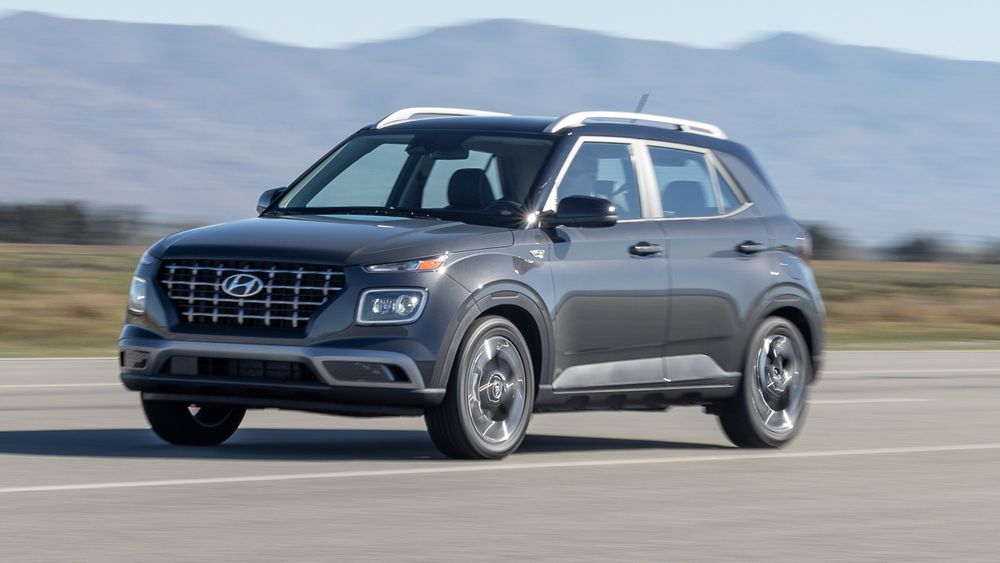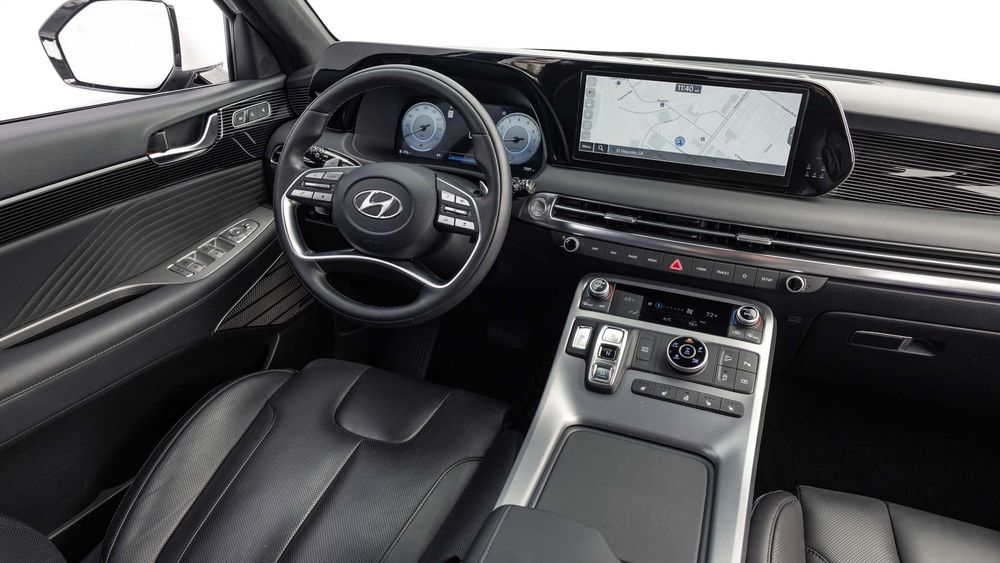2025 Hyundai SUV and Truck Updates and Changes: More Tech for Tucson and Santa Cruz
Hyundai’s SUV lineup consists of efficient hybrids, big family haulers, and an ultra-sporty EV.

Some automakers keep their SUVs staid and predictable, but Hyundai celebrates unconventional approaches. The Korean brand keeps coming up with standout designs, yet its crossovers still generally provide impressive versatility and space to meet the needs of today’s drivers—not to mention appealing quality, technology, safety, and value. Hyundai’s 2025 SUV lineup doesn’t have anything all-new, but several significant and noteworthy updates are worth a closer look. Keep reading to see all the changes on Hyundai SUVs for 2025.

2025 Hyundai Venue: What’s New
Although we’d hoped for a more substantial update this year for Hyundai’s smallest SUV, the 2025 Venue only gains earthy Mirage Green paint as a new option, with eye-catching Apple Green paint being discontinued.

2025 Hyundai Venue: Pros and Cons
Pros
- Affordable base price
- Simple and user-friendly
- Subcompact size makes parking easy
Cons
- Unrefined driving manners
- Minimal interior space
- AWD not available—unlike new 2025 Nissan Kicks

2025 Hyundai Kona: What’s New
Redesigned for 2024, the Kona compact crossover sees minor changes for 2025. Last year, the SEL trim could be had with a Convenience package, now consolidated into the new SEL Convenience trim. Features added in that package carry over, such as a 12.3-inch digital gauge display, wireless charging pad, heated front seats, built-in navigation, and adaptive cruise control.
Drivers who like the Kona N-Line's sporty looks but wouldn’t mind saving about $1,500 can now do so with the 2025 Kona N-Line S trim. The N-Line S model has the same aggressive bumpers, rooftop spoiler, and 19-inch wheels as the regular N-Line. However, that cost reduction shows up in the sunroof, built-in navigation, adaptive cruise control, enhanced front automatic emergency braking, and phone-as-key functionality that the N-Line S lacks compared to the N-Line.
Previously exclusive to the high-end Limited trim, 64-color interior ambient lighting is added to the Kona N-Line S and N-Line for 2025.

2025 Hyundai Kona: Pros and Cons
Pros
- Smart, spacious interior
- Eye-catching exterior design
- Firm brake pedal
Cons
- Turbo models can get pricey
- N-Line looks sportier than it drives
- Hybrid powertrain not available

2025 Hyundai Kona Electric: What’s New
On the Kona Electric, the sporty N-Line treatment is now available for 2025, further enhanced by newly available Ultimate Red metallic paint. Like with the standard Kona, 64-color ambient lighting extends beyond the Limited trim to the new N-Line. Interior LED overhead lighting is added to the Kona Electric N-Line and SEL trims. Also notable is how vehicle-to-load capability is now included across the 2025 Kona Electric range, instead of only the Limited trim as was the case in 2024. This feature allows external accessories and devices to be powered by the SUV's battery.

2025 Hyundai Kona Electric: Pros and Cons
Pros
- Roomy cabin
- Quick and fun to drive with upgrade powertrain
- Sleek styling
Cons
- Doesn’t charge so quickly
- Base model’s reduced power
- Limited model is pricey

2025 Hyundai Tucson, Tucson Hybrid, and Tucson PHEV: What’s New
The current generation of the Hyundai Tucson was introduced for 2022, and it receives an extensive refresh for 2025. Hyundai’s bestselling compact SUV looks much like before, but look closely and you’ll see subtle differences in the headlights, taillights, and bumpers. A 75-millimeter-longer rear wiper blade provides a slight yet appreciable functionality enhancement.
More pronounced changes happen inside the 2025 Tucson, where the redesigned dashboard and center console aim to improve aesthetics and ease of use. Bucking a too-common trend in new cars these days, the Tucson trades its annoying touch-sensitive climate and media control panel for more user-friendly physical knobs and switches—hooray! The air vents are relocated, and there’s now a small shelf ahead of the front passenger. Behind the new steering wheel, some models get a column-mounted shift knob.
Tech improves in this Hyundai SUV. A 12.3-inch infotainment touchscreen is now standard, with wireless Apple CarPlay and Android Auto, along with over-the-air update capability. The touchscreen can be supplemented by a 12.3-inch digital gauge display and head-up display. Power output from the USB-C ports increases for faster device charging. Standard keyless entry with pushbutton start improves convenience, but phone-as-key functionality and a fingerprint scanning system to turn the engine on make things even easier.

2025 Hyundai Tucson, Tucson Hybrid, and Tucson PHEV: Pros and Cons
Pros
- Striking exterior design
- Redesigned cabin improves ease of use
- Long PHEV range
Cons
- Underpowered standard engine
- Stiff ride quality
- Kia Sportage could still be better

2025 Hyundai Santa Cruz: What’s New
The Santa Cruz is essentially a Tucson with a bed, so perhaps it’s no surprise that the updates given to the compact SUV this year also apply to the little truck. Minor styling updates embolden the pickup's appearance, while new Rockwood Green and Canyon Red paint colors become available. Engines carry over, but a towing mode is added to the turbocharged option.
More notable changes happen inside the Hyundai truck. The dashboard is thoroughly reworked, gaining physical controls for climate and media functions as opposed to the clumsy touch-sensitive buttons used previously. Storage is improved by the small shelf ahead of the front passenger seat.
Although Apple CarPlay and Android Auto become standard, the 2025 Santa Cruz makes a 12.3-inch infotainment touchscreen optional, unlike the Tucson where it’s standard. New USB-C ports, over-the-air update capability, phone-as-key functionality, in-car payment for fuel and services, and a fingerprint scanner are features that can enhance everyday ease of use.

2025 Hyundai Santa Cruz: Pros and Cons
Pros
- Drives like a crossover, not a big truck
- Impressive cargo capacity
- Upgraded interior
Cons
- Hearing it’s not a “real truck”
- No hybrid engine choice
- Updated 2025 Ford Maverick is quite appealing

2025 Hyundai Santa Fe and Santa Fe Hybrid: What’s New
Having just been fully—and indeed, drastically—redesigned for 2024, the Hyundai Santa Fe enters 2025 with only one change, as dark Atlantis Blue exterior paint becomes available.

2025 Hyundai Santa Fe: Pros and Cons
Pros
- Funky-cool exterior design
- Brilliant interior packaging and storage
- Hybrid’s great fuel economy
Cons
- Third-row seat isn’t very big
- Hybrid’s slow acceleration
- Overzealous attention monitoring system

2025 Hyundai Palisade: What’s New
Hyundai’s three-row SUV gets some small changes this year. The 2025 Palisade consolidates the previous SEL with Premium package trim into the new SEL Premium trim. Front and rear parking sensors and a 360-degree camera are added to the off-road-inspired Palisade XRT. Auto-dimming side mirrors are removed as standard equipment from the SE and SEL trims but continue in every other version.

2025 Hyundai Palisade: Pros and Cons
Pros
- Looks and feels premium for a Hyundai
- Many standard active safety features
- Quiet inside
Cons
- Soggy driving dynamics
- Fuel economy isn’t great
- Big changes might be coming soon

2025 Hyundai Ioniq 5: What’s New
The Ioniq 5’s refresh this year goes more than skin deep. All versions of the expanded 2025 lineup receive bigger batteries compared to last year, which means improved driving range for returning variants. The SE standard range model picks up an additional 25 miles of EPA-rated range for 245 miles this year, while long-range SE, SEL, and Limited RWD models go from 303 miles for 2024 to 318 miles for 2025. With AWD, the latter trio of trims improves from 260 to 269 miles with 20-inch wheels or 290 miles with 19s. The new high-performance Ioniq 5 N can go as far as 221 miles, and the new trail-curious XRT is capable of 259 miles on a full charge. Both are AWD and feature the long-range battery.
This year’s Ioniq 5 is the first Hyundai to come with a Tesla North American Charging Standard port, and future EVs from the brand will come exclusively with a NACS port. The 2025 model is also the first Ioniq 5 to come out of the company’s new Hyundai Motor Group Metaplant America factory in Georgia, which qualifies the car for the IRS’ EV tax credit.
Portions of the B-pillars, body, and doors have been reinforced for improved side crash protection. Most of the lineup gains revised front and rear bumpers, a new rear spoiler, more aerodynamically efficient wheels, and available flush-type roof side rails. Every variant (finally) gets a rear wiper and washer. Atlas White Matte, Ecotronic Gray Matte, and Celadon Gray Matte are new exterior colors this year. XRT models come with cladding, digital camo styling, 18-inch wheels with all-terrain tires, and a 0.9-inch lift that helps improve approach and departure angles.
Cabin updates include redesigned HVAC controls, a new center console with a toggle for the heated front seats, revised steering wheel, and for SEL trims and higher, standard heated rear seats. Infotainment software improvements make the most of the standard wireless Apple CarPlay and Android Auto. Additional 2025 upgrades include USB Type-C ports front and rear (three in front, two in back), new Smart Cruise Control 2, and an available smartphone-based Hyundai Digital Key 2 Premium for the SEL and above.

2025 Hyundai Ioniq 5: Pros and Cons
Pros
- Ioniq 5 N is mind-blowing fun
- Spacious, upscale interior
- MotorTrend’s 2023 SUV of the Year
Cons
- Tends to lie about its driving range
- N model’s firm ride
- Pricey

2025 Hyundai Nexo: What’s New
Not a single thing changes on Hyundai’s strange and increasingly outdated hydrogen-powered crossover for 2025. This year’s Hyundai Nexo is just as it was in 2024.

2025 Hyundai Nexo: Pros and Cons
Pros
- Futuristic exterior design
- Near-luxury interior
- Eco-friendly
Cons
- Horrible hydrogen infrastructure
- Sold only in California
- Just get an Ioniq 5

2026 Hyundai Ioniq 9: What To Expect
Previewed by the Seven concept, Hyundai’s first all-electric three-row SUV is shaping up to arrive soon. Expect ample interior capacity with room for up to seven passengers, useful tech features, and fast charging speeds to meet the needs of families interested in going electric. Made in the U.S., the Ioniq 9 features a 110-kWh battery pack, larger than the one on the Kia EV9, and is estimated to travel 335 miles on a charge in its longest-range configuration.

2026 Hyundai Ioniq 9: Pros and Cons
Pros
- Three-row seating capacity
- Impressive fast-charging capability expected
- Plenty of tech
Cons
- Might look a bit odd
- Probably more expensive than Palisade
- Better than the Kia EV9?

2025 Hyundai SUVs and Truck:
- 2025 Hyundai Venue: mostly unchanged
- 2025 Hyundai Kona: minor update
- 2025 Hyundai Kona Electric: minor update
- 2025 Hyundai Tucson: significant update
- 2025 Hyundai Santa Cruz: significant update
- 2025 Hyundai Santa Fe: mostly unchanged
- 2025 Hyundai Palisade: mostly unchanged
- 2025 Hyundai Ioniq 5: significant update
- 2025 Hyundai Nexo: unchanged
- 2025 Hyundai Ioniq 9: upcoming model
Alex's earliest memory is of a teal 1993 Ford Aspire, the car that sparked his automotive obsession. He's never driven that tiny hatchback—at six feet, 10 inches tall, he likely wouldn't fit—but has assessed hundreds of other vehicles, sharing his insights on MotorTrend as a writer and video host.
Read More